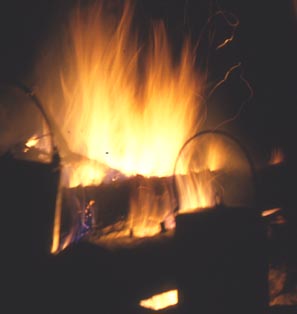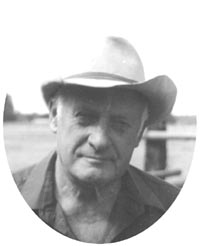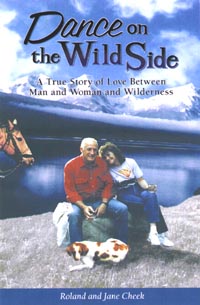a weblog sharing info on outdoor skills and campfire musing by a guy who spends a bunch of time in pursuit of both
CULTURE
WHERE -
TALES ARE TOLD OF
Welcome to Roland Cheek's Weblog
Roland is a gifted writer with a knack for clarifying reality. Looking forward to more of his wisdom
- Carl Hanner e-mail
Aldo Leopold wrote in A Sand County Almanac: "When I first saw the West, there were grizzlies in every major mountain mass." Then he added, ". . . Of the 6000 grizzlies officially reported as remaining in areas owned by the United States, 5000 are in Alaska. Only five states have any at all. There seems to be a tacit assumption that if grizzlies survive in Canada and Alaska, that is good enough. It is not good enough for me. The Alaskan bears are a distinct species. Relegating grizzlies to Alaska is about like relegating happiness to heaven; one may never get there."
To access Roland's weblog and column archives
Tip o' the Day
"Never shoot from 10 a.m. to 3 p.m."
"Seek wildlife subjects that are conditioned to human presence."
"Make sure there's a glint in the eyeball of your subject."
"Photograph people with wildlfie when possible."
All the above advice came from a few of the best wildlife photographers in America. It was during a panel on "Wildlife Photography" at a convention of Outdoor Writers Association of America, back in the 1980s (before digital cameras). I shrugged, smiled in chagrin, and sighed.
There was a time when I would've scribbled furiously at each pearl of wisdom falling from those photographers' lips (I once dreamed of becoming a successful wildlife photographer). That dream -- like a few others -- was discarded when facing reality: that my dogged pursuit of another way of life clashed with making a success of wildlife photography.
At the time of that OWAA annual convention I'd worked as an outfitter and guide in the Bob Marshall Wilderness for nearly two decades, and had been writing newspaper columns about those adventures for six years. Too, I'd photographed and written a coffee table book about that wilderness. But my occupation did not permit exercising the kind of patience necessary for becoming a photographer of wild creatures. To capture wildlife on film, a photographer's first commitment is to his photograph. In my primary occupation, my first commitment had to be the guests I was leading to adventure.
I sighed again. All those top photographers said they seldom use a normal camera lens (55mm). Instead, they use telephoto lenses to 400mm. But the higher-powered lenses are used only with a tripod or stock-mounted support device. Each sometimes shot from blinds -- usually ones they build themselves, going to considerable effort to construct a blend-with-the-surroundings way to stay hidden near a waterhole, meadow, or major game crossing.
Obviously the 10-to-3 edict is to avoid the flat light of midday.
Seeking wildlife subjects conditioned to human presence means shooting for the most part in National Parks or Wildlife Refuges.
The glint-in-the-eye injects life in the animal, but it doesn't mean not shooting a pack of wolves battling a grizzly bear just because you can't get them to stop long enough to capture the glint.
Three years later Jane and I sold our guide service and most of our horses and tack. I remembered the old dream, purchased two top-of-the-line Nikon camera bodies and a powerful variable lens to 200mm, then set out to add support photos to magazine pieces cranked out regularly to America's top outdoor magazines. It wasn't long, however, that I noticed something: the magazines were buying my stories, but they always used someone else's photographs.
My conclusion? Photographers should photograph, writers should write. And never the twain should meet.
FIGHTING OFF DANGEROUS CREATURES
It's not what one might call a user-friendly trail, despite the fact that it has only modest elevation gains, is free of snow earlier than most contemporary path in this far-north part of the Rocky Mountains. The trail does parallel a gorgeous whitewater river for several miles, offers fine views of surrounding mountains, and snakes through a countryside inhabited by an array of North America's most charismatic wild animals. Some of those wild animals, incidentally, are blood-thirsty.
By far and away, the most blood-thirsty of all those wild denizens are Dermacentor andersoni, the Rocky Mountain Wood Tick.
The route to which I refer is the Boundary Trail from West Glacier east, along the southern edge of Glacier National Park. The appeal is that it's a trail that opens weeks before others and is a fairly gentle hike through some of the best of Glacier's winter elk range. Usually by the time snow and ice melt from its tread, Jane and I strain at the bit to get on some trail, Any trail! Thus an early April hike on the Boundary Trail evolved into custom.
The day was sunny and warm. Most of our small group began the hike wearing pullover sweaters and windbreaker trousers, but soon stripped to hiking shorts and short-sleeved shirts. It's six miles to Lincoln Creek--always too high and roily to safely ford as snow melts in the spring. Six miles up and six miles back is about right for our aging group's first hike of the season, even on a balmy spring day.
We'd just crossed the bridge over the Middle Fork of the Flathead at West Glacier to contemplate the sign at our trail's beginning when Jane frowned and plucked at her stocking. "I got a tick--where'd he come from?"
Soon Joe had one, then Brenda, then Jane with another, and Roland. "My, the little boogers seem active today," Brenda muttered.
The lady got that right! By the time we'd reached Lincoln Creek and sprawled on a gravel bar for lunch, each member of our party had dispatched upwards of twenty of the crawly critters. Tell the truth, our nerves jangled while taking note of the massed assaults, then turned raw when our buddy systems for close examinations between husband and wife disclosed accumulated fresh and subversive attacks.
At last we reached Lincoln Creek to sprawl on a gravel bar for lunch. Jane squealed. "There are ticks here!"
"Oh bosh," I said. "They're on the brush, not in the gravel."
This one is crawling up my leg!"
"So? You picked him up from some brush."
"There's another one on my shoe. Roland, they're coming out of the sand!"
I scooted over where she sat. "By God!" I stammered. "She's right! They are coming out of the sand." One--no--two crawled on my right shoe. We leaped up, brushing away the bloody-minded creatures. Minutes later, we gathered up our lunch goodies and headed for home, finishing our sandwiches and oranges while at a jog-trot through a tick gauntlet, heading for more favorable climes.
We fought ticks all the way to the trailhead, picking them from each other, constantly checking our clothing and skin, imagining dozens had escaped our vigilance and was zeroing in on the tastiest parts of our anatomies. At the car, Jane unsnapped the wasteband on her hiking shorts. Two were tucked against her belly button, in hiding. So she disrobed in fron of God and everybody. Five ticks crawled inside her underpanties.
The rest of us had the fortitude to await privacy before checking body parts and clothing seams. One of the more stupid of the little ravishers apparently sought to hide by climbing atop my hair-challenged head. He resembled a carnival clown trying to clamber up a mountaintop snow ghost.
Later, recollecting some of the stripteases I witnessed, I tried to persuade Jane to return to hike the Boundary Trail. "I'll go with you in November," she says. "But if you want someone to go with you in April, call Julia Roberts."
It's an idea.
Roland Cheek wrote a syndicated outdoors column (WildTrails and Tall Tales) for 21 years. The column was carried in 17 daily and weekly newspapers in two states. In addition, he scripted and broadcast a daily radio show (Trails to Outdoor Adventure) that aired on 75 stations from the Atlantic seaboard to the Pacific Ocean. He's also written upwards of 200 magazine articles and 12 fiction and nonfiction books. For more on Roland, visit:
www.rolandcheek.com
Recent Weblogs
Tuesday, March 31, 2009
for more info about these and other Roland Cheek books
There's a bunch of specific info about Roland's books, columns, and archives. By clicking on the button to the left, one can see Roland's synopsis of each book, read reviews, and even access the first chapter of each of his titles. With Roland's books, there's no reason to buy a "pig in a poke."
for detailed info about each of Roland's books
Read Reviews
Read their first chapters
For interested educators, this weblog is especially applicable for use in history, economic, and government classes, as well as for journalism students.
Roland, of course, visits schools. For more information on his program alternatives, go to:
NEXT WEEK:
BIG TICK MEDICINE
www.campfireculture.com
Learning To Talk Bear is Roland's best-selling book, now in its 5th printing. About the book, he writes: "Grizzlies . . . are the Marine Band of the animal world. They swagger with the calm indifference of an animal who knows he has nothing left to prove. . . .
"Not all grizzly bears are Jeffrey Dahmers or Jack the Rippers in fur coats. Perhaps that the "why" for this book."
Roland writes: "Elk took me the wildlife dance over 50 years ago. I became an elk hunter. Then I became infatuated with all God's creatures, and eventually a believer that God's handiwork is composed of such intracacies that a quest to understand has taken the rest of my life. The Phantom Ghost of Harriet Lou is about that quest."
Roland says about Dance On the Wild Side: "This book is about two people in love, sharing a life of dreams amid exciting adventure -- and growing in the process. In reality, it's about any couple who live and love and share and sruggle to achieve the life they wish.
An entire book about a single grizzly bear, a bear that made the pages of The New York Times. Chocolate Legs is a first class murder mystery that may leave you wondering if justice was done
America's first book about what one U.S. Forest Service Chief called, "The Crown Jewel of the Wilderness System." 9 X 12 coffee table size / 97 full-color photos.
One hundred of the best of Roland's 2,700 past newspaper columns and radio scripts
First book in Roland's popular Valediction For Revenge western series
source links for additional info
to send this weblog to a friend
to tell Roland what you think of his Campfire Culture weblog
to visit Roland's newspaper columns and weblog archives









